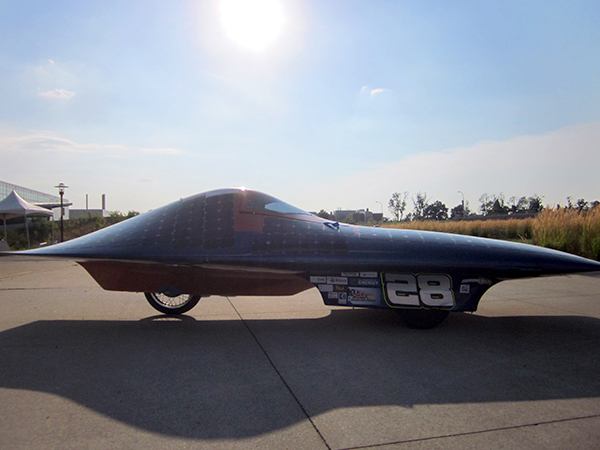
Most college students only dream of a road trip with buddies, but the 2012 SUNY New Paltz Solar Car Team made it a reality when they raced through eight states in eight days.
The annual American Solar Challenge pits American and Canadian collegiate solar car teams in an elite cross-country race. On July 14, qualifying teams charged up their cars for the unforgiving course of 1,650 miles from Rochester, N.Y. to St. Paul, Minn. SUNY New Paltz qualified as the 11th and final team with their car, “the SunHawk III.”
Seven SUNY New Paltz students obsessed over the car to make the SunHawk shine. The team was a mix of engineering, physics, business and art majors, focusing on their specialties during the building process, Raymond Williams, a fifth-year physics major, said.
To optimize performance, Williams said the team devoted two years to designing and researching an improved version of the car and an additional year to build it.
“Trying to do this is your life,” Luke Stover, a fourth-year adolescent education major, said. “You might as well call it your girlfriend.”
Stover said one of his teammates spent every day in June working on the car, even spending some nights in the workshop.
Williams said that the team had roughly half the car completed when they arrived at qualifiers and after four sleepless nights for the team, the first drive occurred on the qualifying track.
With a limited budget of $80,000, Stover said the New Paltz team prided itself on being resourceful. They re-used the centered seat mold from previous races to create the car’s shell.
Stover said the team also had to thriftily reuse batteries from the previous year leading to battery problems that consistently plagued the team during the race. However, the judges — dubbed “scrutineers,” — inspected the car for safety regulations, from its braking system to the loudness of the horn.
SUNY New Paltz completed 96 laps out of the required 106 due to battery problems, but judges granted the team provisional status to compete until the first checkpoint of the race in Erie, Pa.
“The judges knew our car could handle the road, and that was what mattered,” Williams said. “We were lucky.”
But their luck didn’t last. On the very first day, a severed wire in the battery took three precious hours to fix — and landed them in Erie, Pa., a mere half hour after the checkpoint had closed.
Since it was early in the race, Williams said the judges generously lifted their provisional status in light of their unfortunate circumstances. Other provisional teams weren’t so fortunate.
After charging the car for the first few hours of sunlight, Williams said the team raced daily from 9 a.m. to 6 p.m., except the first and last days when they raced from 9 a.m. to 4 p.m.
Recharging the car via solar array occurred from 6 to 8 p.m., but alumnus Julian de la Rua said the downtime was still busy: on an average race day, each member clocked 16-18 hours of preparation and mechanical work.
“As the only electrical engineer, I not only had to design the entire electrical system, but also build it,” de la Rua said. “Hands-on projects like this teach you a lot more than what you learn sitting in a classroom. You just don’t forget it overnight.”
On the road, three approved drivers switched off after two or four hour shifts, de la Rua said. He said that, although the racing was fun, it was highly demanding given the limited vision and movement due to the five-point harness. He said the temperature of the car was never below 100 degrees Fahrenheit, sometimes reaching 120 degrees.
In St. Paul, SUNY New Paltz placed 10th out of 11 competitors on July 21, beating out Massachusetts Institute of Technology. They clocked 116 hours of driving time.
Team advisor Professor Michael Otis said that with a new battery and motor, the team is a top-five contender for next year’s competition.
“We learned a great deal,” Stover said. “With a few adjustments, we feel as a team we can go far.”
April Castillo


Great article. Next year we will win!